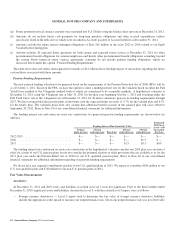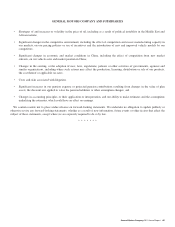General Motors 2011 Annual Report Download - page 62
Download and view the complete annual report
Please find page 62 of the 2011 General Motors annual report below. You can navigate through the pages in the report by either clicking on the pages listed below, or by using the keyword search tool below to find specific information within the annual report.
GENERAL MOTORS COMPANY AND SUBSIDIARIES
Due to the contractual terms of our residual support and risk sharing agreements with Ally Financial, which currently limit our
maximum obligation to Ally Financial should vehicle residual values decrease, an increase in sales proceeds does not have the
equivalent offsetting effect on our residual support and risk sharing reserves as a decrease in sales proceeds.
The following table summarizes the maximum obligation and recorded receivables and liabilities associated with the contractual
terms of our residual support and risk sharing agreements with Ally Financial (dollars in millions):
Successor
December 31, 2011 December 31, 2010
Maximum obligation
Residualsupport .............................................................. $40 $523
Risksharingagreements ........................................................ $88 $692
Outstanding receivables (liabilities)
Residualsupport .............................................................. $ 6 $ 24
Risk sharing agreements ........................................................ $(66) $(269)
The decrease in risk sharing and residual amounts is due to liquidation of the lease portfolio for which we have obligations.
Impairment of Goodwill
At December 31, 2011 we had goodwill of $29.0 billion, which predominately arose upon the application of fresh-start reporting
and the acquisition of AmeriCredit. When applying fresh-start reporting, certain accounts, primarily employee benefit and income tax
related, were recorded at amounts determined under specific U.S. GAAP rather than fair value, and the difference between the U.S.
GAAP and fair value amounts gives rise to goodwill, which is a residual. Our employee benefit related accounts were recorded in
accordance with ASC 712, “Compensation — Nonretirement Postemployment Benefits” and ASC 715, “Compensation — Retirement
Benefits” and deferred income taxes were recorded in accordance with ASC 740, “Income Taxes”. Further, we recorded valuation
allowances against certain of our deferred tax assets, which under ASC 852 also resulted in goodwill. If all identifiable assets and
liabilities had been recorded at fair value upon application of fresh-start reporting, no goodwill would have resulted.
In the three months ended December 31, 2011, 2010 and 2009 we performed our annual goodwill impairment testing as of
October 1 for all reporting units, which are GMNA, GME, GM Financial and various reporting units within the GMIO and GMSA
segments. Based on this testing we determined that goodwill was impaired for our GM Korea reporting unit at October 1, 2011.
Subsequent to our 2011 annual impairment testing we reversed a valuation allowance for our Holden reporting unit that resulted in the
carrying amount of this reporting unit exceeding its fair value and determined that there was an event-driven impairment in our GM
Korea reporting unit. As such we recorded goodwill impairment charges of $270 million in the three months ended December 31,
2011 within our GMIO segment. We recorded goodwill impairment charges of $395 million in the three months ended March 31,
2011 and $621 million in the three months ended December 31, 2011 pertaining to our GME reporting unit. Refer to Notes 3 and 12
to our consolidated financial statements for additional information on these Goodwill impairment charges, including disclosure on our
adoption of Accounting Standard Update 2010-28, “Intangibles — Goodwill and Other: When to Perform Step 2 of the Goodwill
Impairment Test for Reporting Units with Zero or Negative Carrying Amounts”.
When performing our goodwill impairment testing, the fair values of our reporting units were determined based on valuation
techniques using the best available information, primarily discounted cash flow projections. We make significant assumptions and
estimates about the extent and timing of future cash flows, growth rates, market share and discount rates. The cash flows are estimated
over a significant future period of time, which makes those estimates and assumptions subject to a high degree of uncertainty. Where
available and as appropriate, comparative market multiples and the quoted market price of our common stock are used to corroborate
the results of the discounted cash flow method. While we believe that the assumptions and estimates used to determine the estimated
fair values of each of our reporting units are reasonable, a change in assumptions underlying these estimates could result in a material
effect on the consolidated financial statements. Assumptions used in our discounted cash flow analysis that have the most significant
effect on the estimated fair value of our reporting units (excluding GM Financial) include:
• Our estimated weighted-average cost of capital (WACC);
60 General Motors Company 2011 Annual Report
























